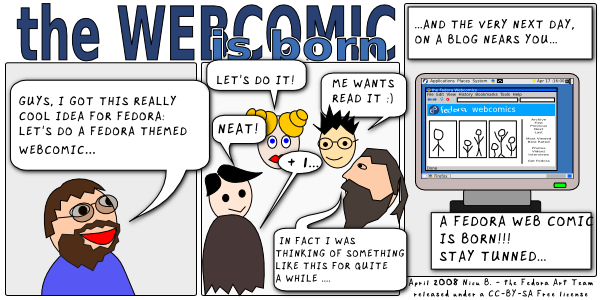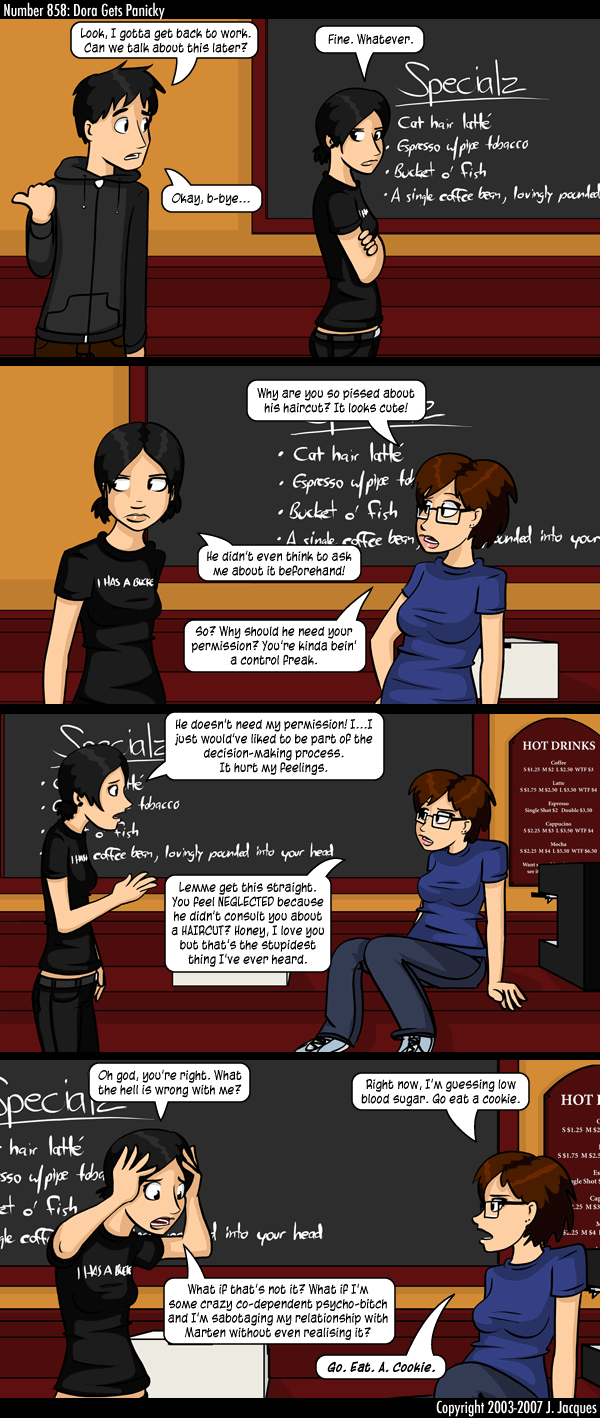According to Scott McCloud, a leading comics biologist, Histoire de M. Vieux Bois, whose printed remains date back to the 19th century, can be considered the first comic book as "the first interdependent combination of words and pictures seen in Europe".
 |
| One of the printed remains of Histoire de M. Vieux Bois. The missing link? Perhaps. |
Comics soon spread across the Atlantic to the United States, but appeared initially only in a leaner form as panel strips in newspapers as the comic strip. Some comic biologist believe that the comic, exhausted from its long journey across the ocean and lacking readily available books for shelter, used the newspaper for its home instead. However, already thin from journey and competing with the sports section for dominance, the comic adapted to fit the limited space available.
 |
| An early comic strip. Notice its slim form and few number of panels. |
You can also see the violence of the characters in the above picture. The comic strip began to developed characters as a defense mechanism, operating like spores which attacked enemies.
 |
| The central character of a late 19th century comic strip celebrating his strip's victory over two boxing articles and the races. |
However, characters began to form complex and sometimes conflicting series of events known as plots. At first, plots were merely limited to the 2-6 panels a comic strip would shed a day, restarting the next day with a new plot. But over time, more and more plots could not be resolved in one day's set of panels, crossing over to the next day, sometimes over weeks, months, or even years.
 |
| This set of panels came first... |
 |
| And this set of panels came after but continues the same plot. |
A consequence of the growing complexity of plots, a phenomena known as continuity arose which became the bane of many comics, as poor continuity was a weakness that comics' natural predator, criticism, took advantage of again and again.
 |
| In the next day's set of panels, the character Popeye complained about the pain in his left hand after punching that guy, when he clearly used his right hand. This inconsistency left a gaping hole for criticism to attack, leaving Popeye with the debilitating stutter he has to this day. |
It wasn't long before comics strips were gathered together and reprinted in books, their natural habitat. However, comic strips found that they could get access to their natural food source, readership, in a different way in books to how they did in newspapers. Whereas a newspaper would guarantee a large readership, that readership often did not keep the newspaper, disposing of it, and thus plots were not reread and newspapers offered a short source of food on a large scale. On the other hand, books were brought to be read and then put on cages known as bookshelves, where they could be taken from at a later date and be read again and again, thus offering a large source of food on a smaller scale. Thus, comic books began to reproduce in greater numbers, especially after the emergence of a new breed (or genre) within the sub-species, Superushērōs Comi, commonly referred to as superhero comics.
 |
| The very first superhero character displaying his dominance over lesser characters from regular comics. |
The superhero became a very popular breed of comic book and proved resilient to the arrival of a new predator on the American literary landscape, a vicious breed of censorship known as the Comics Code. Most comics were unable to adapt to survive the onslaught wrought by Comics Code, but superhero comics manage to by making their characters and plots non-threatening and non-controversial. This gave rise to the term 'playing comic'.
Which is why the character Batman went from this in the 1930s:
 |
| Go on. Make his night. |
To this in the 1960s:
 |
| And besides, I look fabulous! |
Eventually, superhero comics were able to fend off the prowling Comics Code, with their characters becoming grittier over time as a result.
 |
| Seen here are two superhero characters caught in a fight for grittiness. |
However, also in the 1970s, a new breed of comics called Comix emerged that manage to avoid the claws of the Comics Code by finding a safe habitat in an underground network of magazine distribution and thus their characters were able to flourish by on of two ways.
Either by being as nondescript as possible:
 |
| This story goes on for a while... See how the character distracts its reader with a boring tale in order to avoid censorship. |
Or by being blatantly grotesque and controversial in order to shock censorship into submission:
 |
| The Comics Code was struck motionless by the sheer grotesque nature of these characters. |
With the rise of the internet, a whole new digital environment became available for comics to roam. However, in crossing from print to digital, comics had to adapt to their new surroundings evolving into webcomics. Able to achieve a large readership without having to have diverse plots, webcomics were able to have a niche theme for their characters' plots and still get the required readership to thrive.
 |
| The birth of a webcomic. One of nature's true miracles. |
In adapting to the internet, the webcomic has the same slim minimal number of panels as a comic strip, and is closer to that sub-species than to the comic book and superhero comic.
 |
| Not the similarity of the few panels to the comic strip. |
As you might have noticed from the content of the above comic, the internet as an digital environment free of censorship allowed webcomics to flourish in ways that their ancestors, comics and comix, never could, specifically by allowing their characters and plots to engage with taboo subjects.
 |
| That was an abortion joke. This is considered taboo and would be eaten by censors if seen in print. |
Also, not faced with the pressure of the print environment, the plots in webcomics were able to develop slower and more naturally than comics could allow their characters.
 |
| In print that would be the end of the plot, however, in digital, this character agonises over this for the next three years. |
We can see that webcomics, although of the same genus as comic books and comic strips, are actually a new species and should be viewed as such.
 |
| There is nothing more that could be said. |
References:
McCloud, Scott. Understanding Comics: The Invisible Art. New York: Harper Collins & Kitchen Sink Press. 1994. pg 17.
Links:
Check out my songs on YouTube: https://www.youtube.com/sherricale/videos
Pictures-
http://leonardodesa.interdinamica.net/comics/lds/vb/vieuxbois30.asp?p=30
http://graphicnovelistics.blogspot.co.nz/2013_02_01_archive.html
http://www.museoitalianodelfumetto.it/index.php?id=221
http://www.gocomics.com/gasolinealley/2001/07/02
http://www.gocomics.com/gasolinealley/2001/07/03
http://www.lambiek.net/artists/s/segar.htm
http://www.upf.br/nexjor/?p=10360
http://www.styleforum.net/t/220065/batman-dark-knight-rises-movie-thread/960
http://forums.superherohype.com/showthread.php?p=18540894
http://superherosguide.wordpress.com/2011/06/19/social-ethics-how-to-act-in-a-socially-heroic-manner/
http://lessaccurategrandmother.blogspot.co.nz/2012/03/from-off-streets-of-cleveland-comes.html
http://rottenindenmark.wordpress.com/2012/04/
http://nicubunu.blogspot.co.nz/2008/04/lame-webcomic.html
http://www.girlswithslingshots.com/comic/gws-847/
http://www.somethingpositive.net/sp12192001.shtml
http://questionablecontent.net/view.php?comic=858
http://drmcninja.com/archives/comic/5p12/